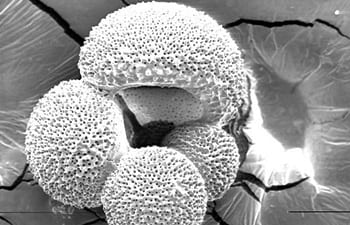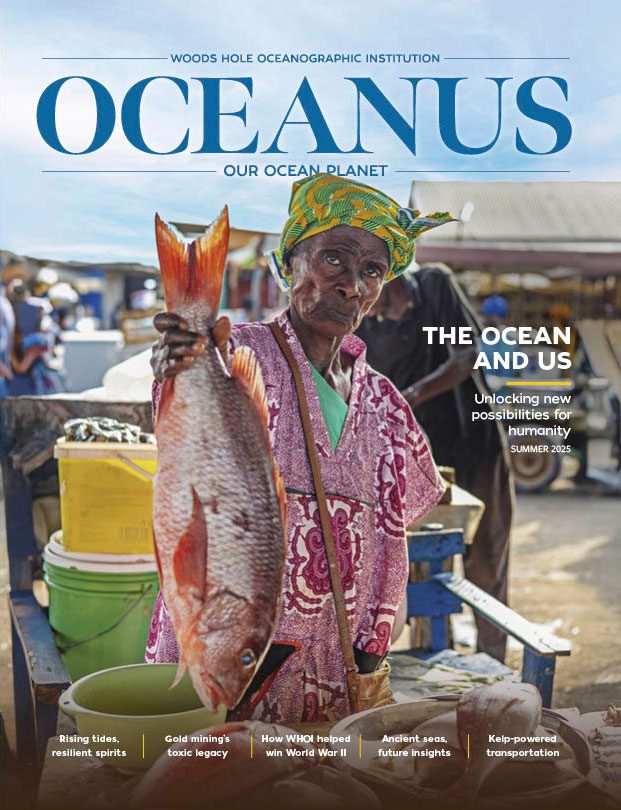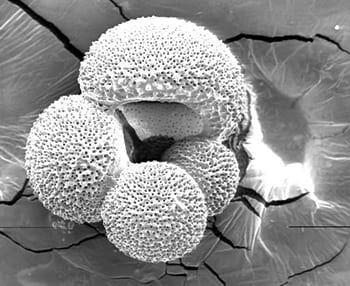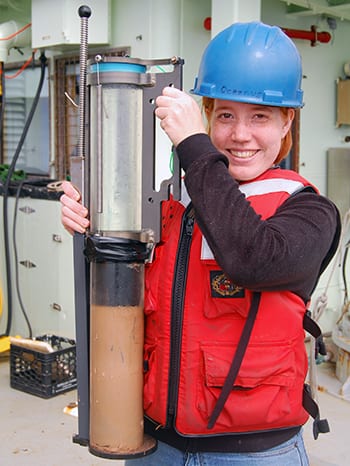
Mentors for Budding Scientists
Young students get a taste of research at WHOI
For the fourth consecutive year, local high school students interested in science spent part of their summer vacations working on projects undertaken with Delia Oppo’s lab at Woods Hole Oceanographic Institution. This year, they teamed up to reconstruct the last 13,000 years of a crucial ocean circulation phenomenon.
The ten students, from Falmouth Academy, Falmouth High School, and Sandwich High School, tracked changes in upwelling near the Galápagos Islands by counting the shells of tiny planktonic creatures that had been recovered from a sediment core.
“The work the kids do is real,” said Oppo, a paleooceanographer at WHOI. “They’re generating data to answer questions that we don’t know the answer to.”
Oppo started the Climate Summer Internship Program in 2009 with Joanne Muller, a former WHOI postdoctoral scientist who was teaching at the academy, to give students experience doing research. The academy provided the space and microscopes and the WHOI Ocean and Climate Change Institute provided funding for other equipment and small stipends for the students and Muller.
The program had seven participants in its first year. In 2012, Oppo had to turn away two students because the program only had enough space and microscopes for ten.
“This year was the most we ever had,” she said. “We had to hunt down microscopes, actually, and take them from my lab.”
For one week this past July, the students met in a lab at Falmouth Academy every morning for a half-hour lecture and a few hours of work at the microscope. Their project focused on waters near the Galápagos Islands, where cold, nutrient-rich water upwells from great depths to near the ocean’s surface. Upwelling around the Galápagos is more pronounced when easterly winds are strong, for example during La Niña periods of the El Niño-Southern Oscillation (ENSO) cycle. If you can tell when upwelling occurred and when it didn’t, you can sketch a history of equatorial winds, which might relate to ENSO phases during the same time.
The students got a glimpse of past episodes of upwelling by looking for the shells of foraminifera, or forams, single-celled organisms that lived in the ocean, fell to the seafloor after they died, and were embedded in a sediment core recently extracted by scientists.
Each student was given sieved samples of foram shells, a microscope, and a counting device for recording the total number of forams and the number of the species called Globigerina bulloides. This species lives near the surface and has a strong preference for cold, nutrient-rich water, making it an excellent indicator for upwelling.
This was the first year Oppo’s interns studied the forams from the Galápagos area. In 2009, the group generated a record of upwelling from the Indonesian seas, which they related to monsoon winds. The 2010 students produced a record of icebergs carried to the subpolar North Atlantic by counting the number of small rocks that had been delivered to the sediment core site by icebergs. Those classes produced original findings that Oppo and Muller are still pursuing. They also started at least one student on her own path into scientific research.
“The first year we actually had a student ask if she could work for us,” said Oppo. “She ended up doing a science fair project with me, and ended up with a first prize in the state, and was one of eight students in Massachusetts who was invited to give a talk in a special session at the AAAS [American Association for the Advancement of Science] meeting in D.C.” She is now an undergraduate at Yale.
The interns aren’t the only ones to benefit from the program. This year’s students were taught by WHOI postdoctoral fellow Jennifer Arbuszewski, who welcomed the opportunity to plan and prepare the lectures and supervise the lab work.
“For Jenny it was a good opportunity to teach,” said Oppo. “And not only to teach, but also to develop the course materials. She put together all the presentations.”
Arbuszewski’s lectures covered the ENSO system, foraminifera, sediment cores, anthropogenic climate change, and paleoclimate. After the students finished their work on Thursday, she graphed their results and presented them for discussion by the group on Friday.
Their data showed periods of upwelling alternating with periods without upwelling, consistent with results from other sources. It also revealed an extended and massive upwelling several thousand years ago, an unexpected finding that underscored for the students that they had done genuine research and not just a lab exercise.
“A lot of them seemed excited about the results, and that there was a story there,” said Arbuszewski. “All the kinks aren’t worked out yet, but there’s definitely something in their results that’s pretty interesting.”
From the Series
Slideshow

Slideshow

- This species of foraminiferan, Globigerina bulloides, is a good indicator of the upwelling of cold, nutrient-rich water. (Photo courtesy of NOAA)
- WHOI postdoctoral fellow Jennifer Arbuszewski prepared the lectures and supervised the lab work for this year's students in the Climate Summer Internship Program. The program was started by WHOI paleooceanographer Delia Oppo. (Photo by Peter deMenocal)
Related Articles
- Paddling an angry, ancient ocean
- Reconstructing the Bering Sea’s stormy past
- Coral time machines
- Secrets in the dust
- How historic hurricanes can help predict storm intensity
- Unearthing Long-Gone Hurricanes
- Will Oxygen in the Ocean Continue to Decline?
- Blue Holes and Hurricanes
- More Floods & Higher Sea Levels
Featured Researchers
See Also
- Delia Oppo Delia Oppo's website
- The Once and Future Circulation of the Ocean Oceanus article coauthored by Delia Oppo


